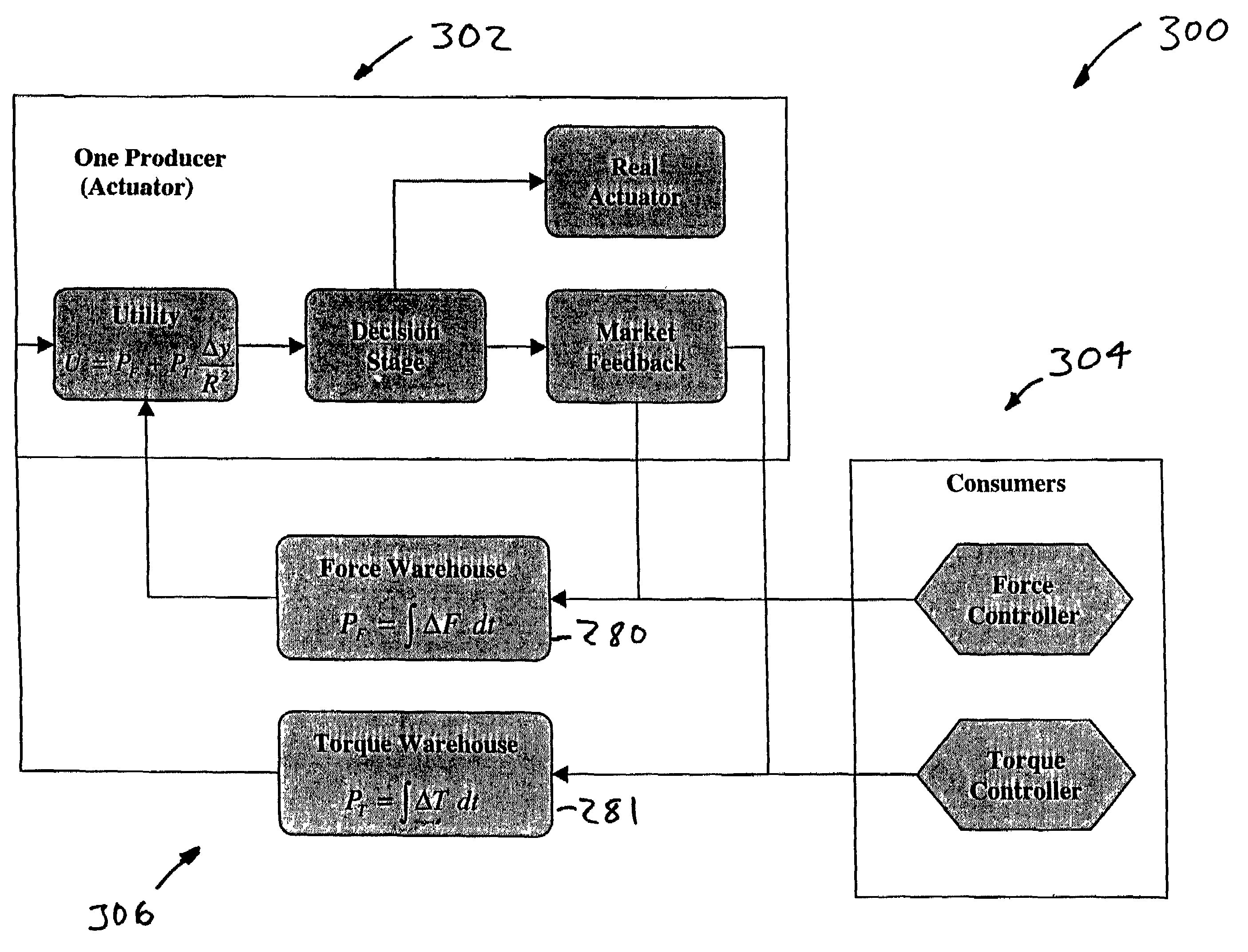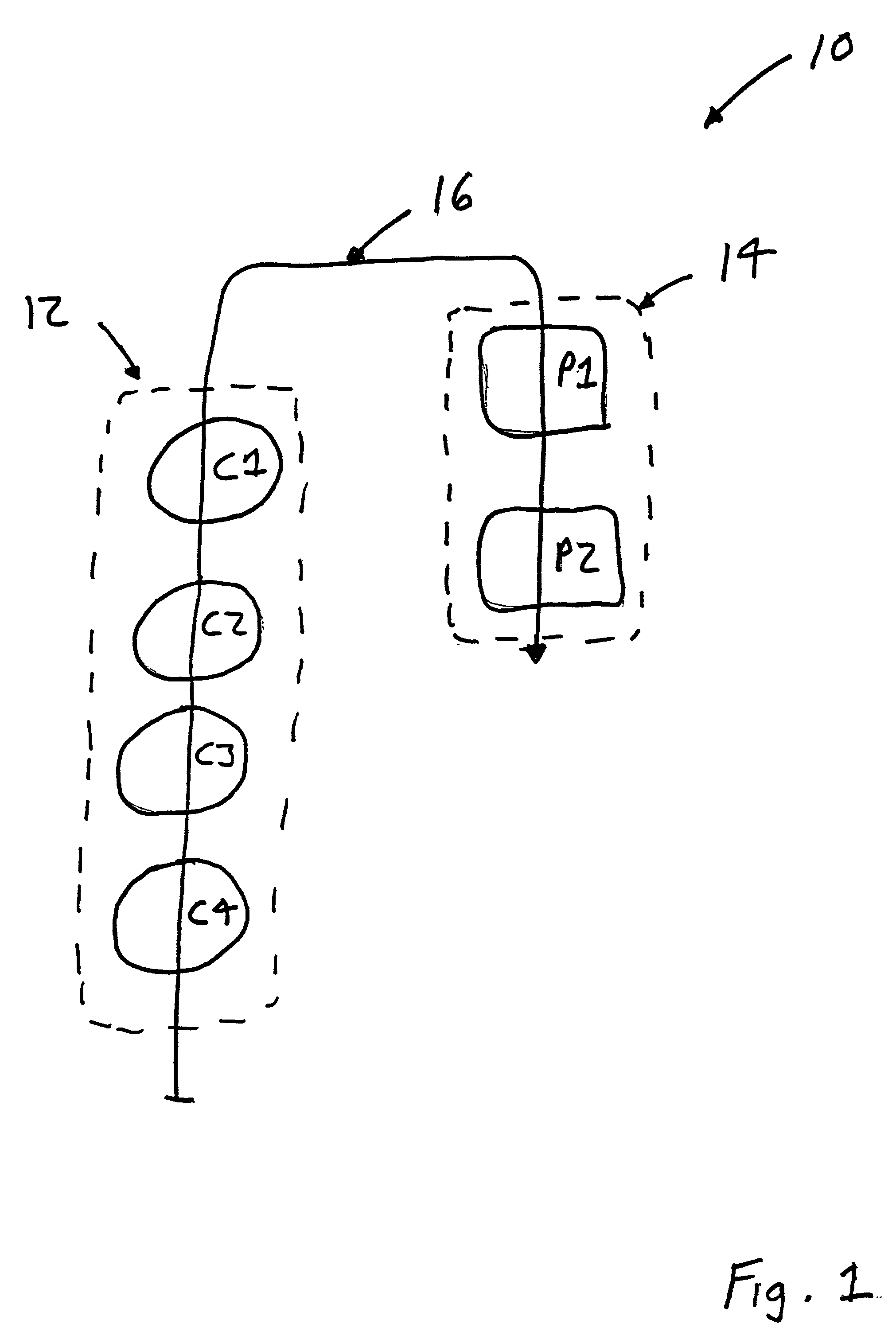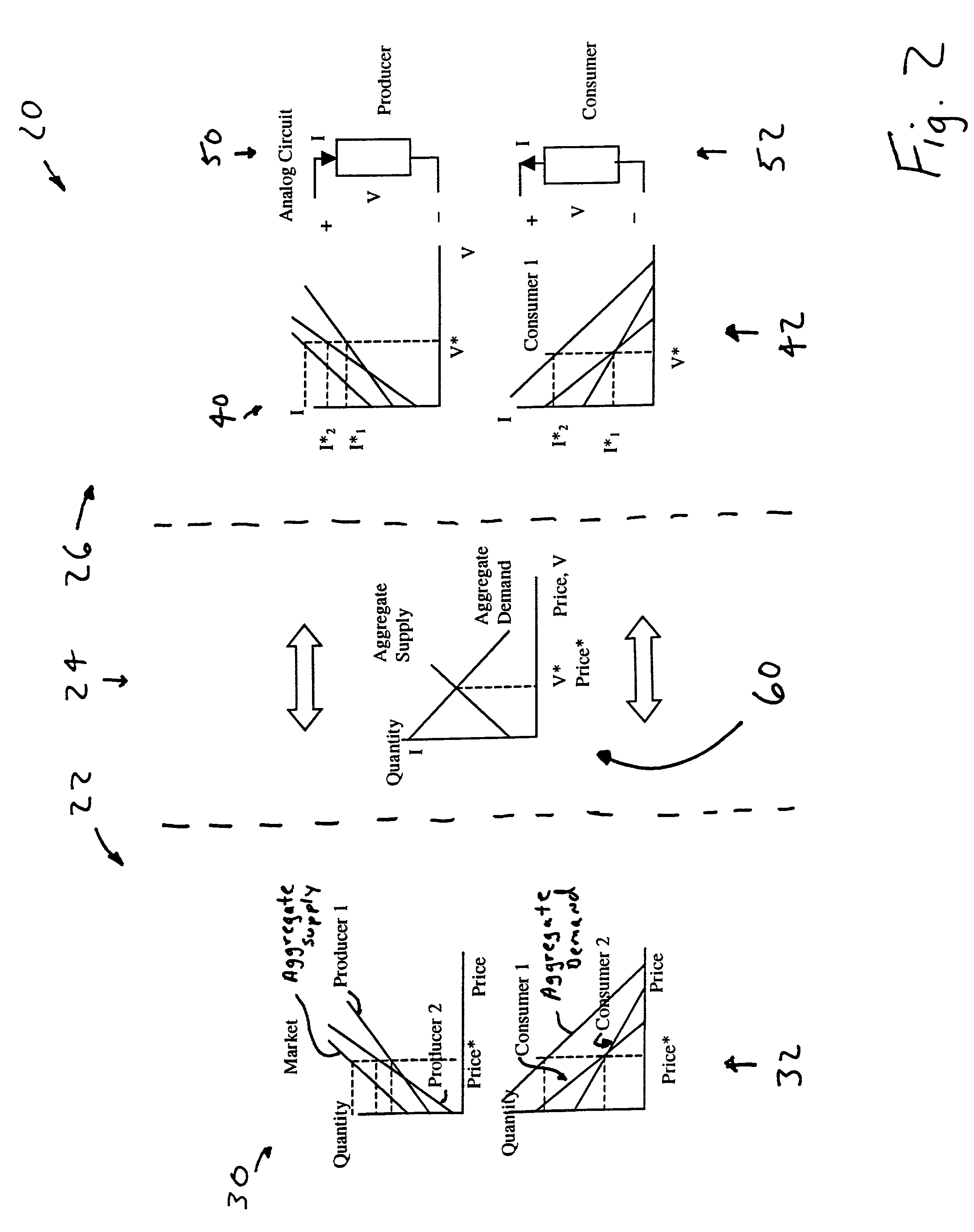[0006]Implementation of the foregoing control schemes is of particular utility for problems requiring a large number of actuators to produce a desired actuation level. In this case there would be one
consumer with a flat demand curve, i.e., a
current source, for which the current (demand) does not change with
voltage (price). The actuators (producer agents) would produce actuation such that all this current is removed to ground (demand balanced by supply). This
high bandwidth, asynchronous coordination occurs through one wire and can be inexpensive per connection (only a few chips per node). No explicit computation is required to allocate the resources and a near optimal solution is obtained from a possibly degenerate set of equivalent solutions.
[0007]Advantageously, like traditional economic markets, analog circuit implementations of the present invention are robust against changes in actuator function or failures. As the cost per unit functionality of sensors, actuators, and computers (agents) continues to decrease, control systems comprised of many interconnected elements become increasingly practical. High speed systems having 103 processors with 10 market wires connected with multiplexed A / D's and D / A's or multiple op amp packages operating in real time are economically feasible using apparatus and methods of the present invention. Such systems could be much more responsive to events in their environment and internal states as well as exhibit robustness against component failure. Such an analog electronic implementation is distributed, flexible, easily extensible, efficiently uses wires, and reduces the communication load. Analog markets that can compute weighted sums of up to 104 spatially distributed agents and communicate the resulting sum back to agents in about 1–10 μsecs are supportable. The complexity of each such node is about 1–3 op amps per node or one embedded processor
chip per node for the more flexible implementations.
[0008]In one preferred embodiment of the present invention, a distributed
market based analog control system includes multiple producing units, each producing unit having an output responsive to a market price. Production levels are in part determined by needs of multiple consuming units, each consuming unit also having an input responsive to a market price. Communication of pricing information between the producing units and the consuming units is mediated by a marketwire connecting multiple producing units to multiple consuming units. Absolute or relative voltage level, current level, or frequency of voltage or current level changes can all be used to represent price information on the marketwire. For voltage level based pricing schemes, typically voltages of about 5–10 volts are used. Since
noise based voltage fluctuations on the marketwire are typically less than about 1.0 mV, as much as 10 bits of precision is available for distinguishing price levels in the
system. To simplify construction, reduce cost, and enhance system robustness, substantially identical adjustable circuit elements can be used for both multiple producing units and multiple consuming units, with the substantially identical voltage adjustable circuit elements being connected to the marketwire.
[0009]In a particularly preferred embodiment of the present invention, the distributed market based
control system has no central controller for setting market prices. In the absence of either a central controller or a central timing mechanism, both of which can be expensive, prone to failure, or introduce substantial delays in price computation and distribution, the reliability of the system is improved. In operation, a producing unit having an output responsive to a market price, a consuming unit having an input responsive to a market price, are connected to a marketwire connecting the producing unit to the consuming unit with changes in analog electrical characteristics of the marketwire representing market price fluctuations. These analog electrical characteristics of the marketwire can be voltage level changes, current level changes, or time or
frequency domain changes in electrical properties. Such a system operates asynchronously, without a central timing
clock, with the marketwire immediately transmitting changes in price information on a
microsecond scale, with no need for
polling or n-way exchanges of information between n number of producers and consumers.
[0011]As will be appreciated, since not all producers (consumers) are capable of providing a continuous range of actuation (demand) in response to a continuous range of received prices, some mechanism for handling stepped (or quantized) actuator response functions without introducing unwanted oscillations is needed. More generally, while it may not be possible to balance supply and demand exactly at each instance of time it can be possible to balance the time averaged supply and demand. The present invention provides such a mechanism by employment of an inventory or buffer unit to temporarily store excess output or demand and permit market equilibration. The inventory unit may be attached, along with producing units and consuming units, to a single marketwire or incorporated into individual or groups of producing and / or consuming units. In operation, for example, the inventory unit can inject additional charge, raise voltage level, or adjust vibrational amplitudes to smoothly equilibrate the market of consumers and producers.
[0013]Multiple markets can be used to reconcile conflicting
resource allocation, a problem that nearly always occurs in
real systems. The present invention provides a smooth robust balance between conflicting goals. A market wire is established for each resource to be allocated. The actuators (producers) and consumers for each resource participate in a market that establishes a price for each resource. The utility curve for each agent (consumer or producer) that participates in more than one market, represents a weighted combination of each resource. The operation of the aggregate response to the various markets produces a robust, continuous, and optimal solution for conflicting
resource allocation. The analogy to traditional economic markets such the allocation between apples and oranges, for example, is that each individuals utility curve expressing their preference for apples verses oranges at a given prices, determines not only how many apples and oranges an individual receives, but also how conflicting resource demands for apple and orange production are resolved.
 Login to View More
Login to View More  Login to View More
Login to View More 


